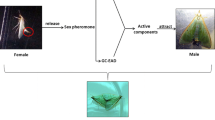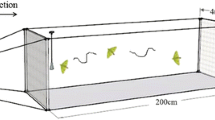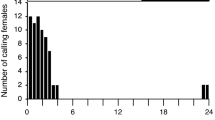Abstract
The lackey moth Malacosoma neustrium (L.) (Lepidoptera Lasiocampidae) is a common pest of many forest and cultivated broadleaf trees. Analysis by GC-EAD of gland extracts and female effluvia showed the presence of two active peaks that were characterized as (E,Z)-5,7-dodecadienal (E5,Z7-12:Ald) and (E,Z)-5,7-dodecadienol (E5,Z7-12:OH) according to their GC retention times, mass spectra, and electroantennographic activity. (E,Z)-5,7-dodecadienyl acetate (E5,Z7-12:Ac) was also detected in the gland extracts. The average amounts of E5,Z7-12:Ald, E5,Z7-12:OH, and E5,Z7-12:Ac extracted from an abdominal tip were 113.2 ±22.0 ng, 29.9 ±6.2 ng, and 11.6 ±2.0 ng, respectively. In the effluvia from single females, on the average, 1.9 ±0.7 ng/min of aldehyde and 0.3 ±0.1 ng/min of alcohol were collected. In wind tunnel tests, male behavioral sequences elicited by E5,Z7-12:Ald alone or in 3:1 and 9:1 blends with the corresponding alcohol were similar to those evoked by one female equivalent of sex pheromone gland extract. Field trapping experiments showed that E5,Z7-12:Ald is essential to attract male moths. On adding E5,Z7-12:OH to E5,Z7-12:Ald in 1:3 and 1:9 ratios, male attraction slightly increased whereas in a 1:1 ratio, the attractiveness of E5,Z7-12:Ald was reduced.
Similar content being viewed by others

REFERENCES
De Cristofaro, A., Anfora, G., Germinara, G. S., Cristofaro, M.,and Rotundo, G. 2003. Biological activity of Solanum tuberosum L. volatile compounds on females of Phthorimaea operculella (Zeller) (Lepidoptera, Gelechiidae) females. Phytophaga XIII:53–61.
De Cristofaro, A., Rotundo, G., and Germinara, G. S. 2000. Electrophysiological and olfactory responses of Ephestia kuehniella Zeller adults to cereals' semiochemicals. IOBC WPRS Bull. 23(10):189–194.
Den Otter, C.J., De Cristofaro, A., Voskamp, K. E., and Rotundo, G. 1996. Electrophysiological responses of chestnut moths, Cydia fagiglandana and C. splendana (Lep., Tortricidae) to sex attractants and odours of host plants. J. Appl. Entomol. 120:413–421.
Hill, A.S. and Roelofs, W. L. 1980. Chemical structure of insect sex pheromones: some recent developments, in Abstracts XVI International Congress of Entomology, Kyoto, Japan. Abstract 7S-6,30.
Kaissling, K.E. and Thorson, J. 1980. Insect olfactory sensilla: Structural, chemical and electrical aspects of the functional organization, pp. 261–282, in D. B. Sattelle, L. M. Hall, and J. G. Hildebrand (eds.). Receptors for Neurotransmitters, Hormones, and Pheromones in Insects. Elsevier/North Holland Biomedical Press, New York.
Kochansky, J., Hill, A., Neal, J.W., Bentz, J.-A., and Roelofs, W. 1996. The pheromone of the eastern tent caterpillar, Malacosoma americanum (F.) (Lepidoptera, Lasiocampidae). J. Chem. Ecol. 22:2251–2261.
Konyukhov, V.P. and Kovalev, B. G. 1988. Sex pheromone of lackey moth (Malacosoma neustrium L.) females. Bioorg. Khim. 14:268–272.
Linn, C.E., Jr. and Roelofs, W. L. 1995. Pheromone communication in moths and its role in the speciation process, pp. 263–300, in D. M. Lambert and H. G. Spencer (eds.). Speciation and the Recognition Concept. Johns Hopkins University Press, Baltimore, MD.
Luciano, P., Delrio, G., and Prota, R. 1982. I defogliatori delle foreste a Quercus suber L. Studi Sassaresi sez. III. Annali Facoltà di Agraria dell'Università di Sassari 29:321–365.
Luciano, P. and Roversi, F. 2001. Fillofagi delle querce in Italia, pp. 36–40. Industria Grafica Poddighe. Predda Niedda (SS), Italy.
Melikyan, G. G., Kovalev, B. G., Konyukhov, V.P., Azaryan, G.KH., and Badanyan, SH.O. 1980. Isolation of the sex pheromone of Malacosoma neustrium L. Arm. Kim., Zh. 33:519–523.
Rotundo, G., Germinara, G. S., De Cristofaro, A., and Riolo, P. 2001. Sex pheromone of the Italian population of Sesamia cretica (Lederer) (Lepidoptera: Noctuidae), pp. 357–364, in XXI IWGO Conf., October 27-November 3, 2001, Padua-Venice.
Rotundo, G., Giacometti, R., and Rotundo, A. 1984. Individuazione degli attrattivi sessuali dei Tortricidi delle castagne mediante studio elettroantennografico e di campo. Boll. Lab. Ent. Zool. Agr. "Filippo Silvestri" 41:211–224.
Ryan, T. A. 1960. Significance tests for multiple comparison of proportions, variances, and other statistics. Psychol. Bull. 57(4):318–328.
Underhill, E.W., Chisholm, M. D., and Steck, W. 1980. (E)-5,(Z )-7-Dodecadienal, a sex pheromone component of the western tent caterpillar, Malacosoma californicum (Lepidoptera, Lasiocampidae). Can. Entomol. 112:629–631.
Author information
Authors and Affiliations
Rights and permissions
About this article
Cite this article
Rotundo, G., Germinara, G.S. & Cristofaro, A.D. Chemical, Electrophysiological, and Behavioral Investigations on the Sex Pheromone of Lackey Moth, Malacosoma neustrium . J Chem Ecol 30, 2057–2069 (2004). https://doi.org/10.1023/B:JOEC.0000045595.75746.42
Issue Date:
DOI: https://doi.org/10.1023/B:JOEC.0000045595.75746.42



